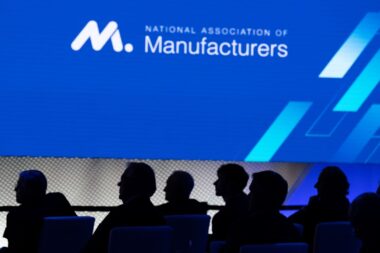NAM Announces New Leadership

Yesterday, NAM President and CEO Jay Timmons announced recent changes to the organization’s leadership team.
Newhouse to senior advisor: Last month, NAM Senior Vice President Aric Newhouse announced he would step back from his day-to-day management responsibilities of the policy and government relations teams on July 1. Newhouse will now serve the NAM as a senior advisor.
Aligning advocacy: Managing Vice Presidents Chris Netram and Jordan Stoick, respectively, will lead the NAM’s best-in-class policy team and government relations team. To further combine the strengths of the NAM’s government relations, public affairs and communications operations, Stoick and Netram will report to NAM Executive Vice President Erin Streeter.
- Over the past few years, Streeter has led engagement with all of the NAM’s external stakeholders, overseeing advocacy campaigns and key relationships with the White House and members of Congress, while continuing her leadership of communications, marketing and brand reputation.
- “I’m excited about what this means to further integrating our advocacy efforts,” said Timmons following the announcement. “These changes will elevate the leadership and expertise of our best-in-class policy professionals.”
Membership: NAM Chief of Staff Alyssa Shooshan will take on the role of senior vice president of membership in addition to her current roles of overseeing the executive office and the board initiatives teams. Jeff Pierce will increase his focus on sponsorships, issue advocacy development and new member growth as the senior vice president of strategic development. Pierce’s leadership has been instrumental in the rapid growth of sponsorships and other new revenue streams, and he will continue to lead their expansion.
- These changes bring the membership and board initiatives teams into closer alignment. They also recognize the demand from NAM members to grow operational and thought leadership programming.
The last word: “As Aric steps back after 16 years, he leaves a record of accomplishment widely recognized by his peers in the association community,” said Timmons. “From being named CEO Update’s Association Lobbyist of the Year in 2016, to The Hill naming him a ‘top lobbyist’ for many years, to his most recent inclusion in Washingtonian Magazine’s Top 500 Influential list, his wisdom, influence and bipartisan approach are legendary.”
- “There are two things any high-performing organization looks to achieve in these moments of change: continuity and improvement. And that’s what this leadership will deliver—to continue advancing the competitiveness of manufacturers in the United States.”
Stopping the DOE’s Regulatory Onslaught

The Save Our Gas Stoves Act—which is expected to pass the House in the near future, though it has been temporarily blocked due to an argument over the debt ceiling—would prevent the Department of Energy from moving forward with its overly stringent efficiency threshold for gas stoves.
That would be a win for reining in DOE overreach, but work remains in the fight against a regulatory onslaught by the agency. The NAM and its association partners are leading the way.
What’s going on: Since January, the DOE has undertaken an unprecedented slew of regulations aimed at home appliances—and if implemented, these measures would yield little in the way of energy savings for consumers and result in appliances that cost more.
- They would pile on the costs for manufacturers, too—more than $2.5 billion, according to the DOE’s own estimates, in a package of standards that could go into effect as early as 2027.
- “There are currently nine open rules [from the DOE] on appliance products that have very little energy savings for the consumer while they have really significant cost to the industry,” said Association of Home Appliance Manufacturers Vice President of Communications and Marketing Jill Notini, whose organization isurging consumers to call on Congress to support the Save Our Gas Stoves Act.
The background: Under the Energy Policy and Conservation Act, the DOE is required to review appliance-efficiency standards every six years—but it’s not required to tighten them, Notini said, adding that the last time reviews were done for gas cooking appliances, the agency opted against making any changes.
Higher costs for all: These new DOE standards would significantly raise production costs for manufacturers while reducing features, performance and affordability for consumers, according to AHAM calculations based on DOE data.
- Consumers would save just $1.51 a year in energy costs, or 12.5 cents a month.
Too tight: It’s no surprise, then, that the proposed standards are so stringent as to make almost all on-the-market gas ranges noncompliant, Notini said.
- According to the DOE’s own technical analysis, 96% of gas cooking appliances would fail to meet the proposed efficiency threshold.
- The standards would have a significant effect on consumers, too. Redesigned gas stoves would only be able to have a single high-input burner, increasing the amount of time it would take to boil water or cook a meal, Notini said.
Washing machines: Another recently proposed DOE regulation requires that washing machines use almost 25% less water and cooler water temperatures, a restriction that would also hit consumers hard.
- The point-of-purchase price tag for washing machines would increase $150 per washer—while saving consumers just $7.85 a year, according to the DOE.
- Inflation has become a major concern for consumers across income segments, but particularly among low- to middle-income households, which will see the biggest impact from the proposed standard, Notini pointed out.
The last word: “Manufacturers rely on regulatory clarity and certainty. Unfortunately, DOE’s proposals only add to the regulatory onslaught manufacturers are currently facing,” said NAM Director of Energy and Resources Policy Chris Morris.
- “The NAM remains committed to working with all federal agencies, including the DOE, to ensure that rules and regulations are practical and feasible and do not harm manufacturers.”
Manufacturers Congratulate Negotiators on Bipartisan Effort to Reach Debt Ceiling Compromise, Urge Swift Passage
Washington, D.C. – Following an announcement that the White House and House Speaker Kevin McCarthy (R-CA) had reached a deal to avoid default on U.S. debt, National Association of Manufacturers President and CEO Jay Timmons released the following statement:
“Manufacturers congratulate President Biden, Speaker McCarthy and their negotiating teams on reaching an agreement to lift the debt limit. As we have said from the beginning, defaulting on our debt would create economic chaos, harming manufacturing workers and their families and jeopardizing our leadership in the world. Congress should act quickly to pass this agreement and to demonstrate to Americans and to the world the continued strength of our institutions and our democracy.
“Manufacturers have been a leading voice for permitting reform, so we are encouraged that this legislation takes critical steps to improve our broken permitting system, helping us more fully leverage our domestic energy sources and expand manufacturing in the United States. We will work with Congress and the administration to build on this progress and create a comprehensive bipartisan permitting reform package that also helps unlock the full potential of laws meant to encourage the growth of manufacturing in America, such as the historic infrastructure law and the CHIPS and Science Act.
“Once this debate is behind us, our leaders must turn their focus to other policies critical to unleashing manufacturing’s full potential: addressing the crushing regulatory burden facing manufacturers, improving our immigration system and ensuring that our tax code supports manufacturing in America by encouraging investments in innovation and capital equipment.”
-NAM-
The National Association of Manufacturers is the largest manufacturing association in the United States, representing small and large manufacturers in every industrial sector and in all 50 states. Manufacturing employs nearly 13 million men and women, contributes $2.90 trillion to the U.S. economy annually and accounts for 55% of private-sector research and development. The NAM is the powerful voice of the manufacturing community and the leading advocate for a policy agenda that helps manufacturers compete in the global economy and create jobs across the United States. For more information about the NAM or to follow us on Twitter and Facebook, please visit www.nam.org.
Bechtel, Siemens Talk Infrastructure and Workforce

Implementation of programs and funding from 2021’s historic, bipartisan Infrastructure Investment and Jobs Act is now in full swing—and manufacturers are already hard at work.
What’s going on: During discussions at an Infrastructure Week event hosted by United For Infrastructure earlier this month, leaders from Bechtel and Siemens USA discussed the significant social and economic impact of infrastructure investment.
- The Business Roundtable “commissioned a study to look at the economic impact [of] every taxpayer dollar invested in infrastructure, and we concluded that [each dollar] generates $4 in economic growth,” said Bechtel Chairman and CEO Brendan Bechtel, who is also chair of the BRT Infrastructure Committee. “We concluded that a trillion dollars in infrastructure investment over 10 years unlocks, on average, additional household disposable income of $1,800 a year for every family in the United States. Modern infrastructure creates a huge amount of social, environmental and economic benefits.” Bechtel spoke alongside Maryland Gov. Wes Moore and White House Senior Advisor and Infrastructure Coordinator Mitch Landrieu on a panel.
- More benefits of the investment in infrastructure are on display in the many projects of industrial technology company Siemens USA, according to the company’s Vice President and Head of U.S. Government Affairs Brie Sachse.
- Sachse discussed the recent opening of Siemens’ second U.S. electric-vehicle charging manufacturing hub in Carrollton, Texas, as well as a partnership with utility ComEd in the historic Bronzeville neighborhood of Chicago. There, Siemens is providing the management software for a first-of-its-kind, utility-owned microgrid cluster. “It will lead to cleaner, more reliable power for a neighborhood in the midst of revitalization,” Sachse said during a lightning round at the event. “We’re enthusiastic about the momentum to electrify America.”
Permitting reform and workforce: Both Bechtel and Sachse stressed the critical importance of filling current and future open manufacturing jobs. Bechtel echoed NAM President and CEO Jay Timmons—who spoke on an earlier panel—when he stressed the need for infrastructure-project permitting reform at the congressional level.
- “The shortage of construction workers is real. It’s the current constraint throttling how much work we feel we can responsibly commit to and deliver at once,” Bechtel said. “I think it’s the single most important thing that we can all address besides permitting reform.”
- After the event, Bechtel thanked industry allies and business leaders “for continuing to lead on improving the permitting system so we can move projects through the pipeline more efficiently.”
The power of apprenticeships: The companies are betting on apprentice programs to help fill jobs.
- Siemens recently launched an apprentice program in Wendell, North Carolina, to “support the growing EV market,” Sachse said, adding that apprenticeships like this one are “opening the door for career pathways that are both well-paying and meaningful.”
- To fill the worker shortage, “we’re doubling down on the things we know that work,” Bechtel said. For example, the company uses apprentice readiness programs, in which people are “learning while they’re earning [and] they’re accessing and accumulating health and retirement benefits that they wouldn’t otherwise.”
Supreme Court Provides Path to Regulatory Certainty for Manufacturers in Waters of the U.S. Ruling
Washington, D.C. – Following the U.S. Supreme Court’s decision in Sackett vs. Environmental Protection Agency, National Association of Manufacturers Vice President of Energy and Resources Policy Brandon Farris released the following statement:
“The Supreme Court’s decision today will help put us on a path to regulatory certainty for manufacturers across the country as all the justices agreed that the EPA had overstepped its authority under the Clean Water Act. Manufacturers are committed to keeping our waters clean and demonstrating environmental stewardship, but Clean Water Act enforcement has been rife with ambiguities and inconsistencies, often allowing the EPA to overreach and attempt to regulate water—and even dry land—that is far beyond the scope of the law. This case demonstrates yet again why manufacturers and our economy need a sensible Waters of the United States proposal that provides clarity and certainty and allows the industry to continue leading the way on environmental protection. The EPA should heed the court’s ruling and revise its latest WOTUS proposal.”
Background:
Previously, the NAM submitted multiple sets of comments regarding the 2015 WOTUS rule to better inform policymakers. In addition, the NAM supported the 2017 executive order instructing the EPA to rescind the rule, and the NAM Legal Center had been in active litigation against the rule starting in 2015. The legal battle included a unanimous victory for the NAM at the U.S. Supreme Court on a key procedural issue, and in 2019, federal judges invalidated the rule.
-NAM-
The National Association of Manufacturers is the largest manufacturing association in the United States, representing small and large manufacturers in every industrial sector and in all 50 states. Manufacturing employs nearly 13 million men and women, contributes $2.90 trillion to the U.S. economy annually and accounts for 55% of private-sector research and development. The NAM is the powerful voice of the manufacturing community and the leading advocate for a policy agenda that helps manufacturers compete in the global economy and create jobs across the United States. For more information about the NAM or to follow us on Twitter and Facebook, please visit www.nam.org.
NAM to SEC in Court: Get Activist Shareholders Out of Boardrooms

Activist shareholders from across the ideological spectrum have increasingly influenced public companies’ proxy ballots, and the Securities and Exchange Commission has unlawfully become their willing partner. That’s why the NAM has moved to intervene in a court case on the matter.
What’s going on: The NAM yesterday filed a motion to intervene in a case challenging the SEC’s authority to compel manufacturers to use their proxy ballots to speak about divisive social and political issues that are unrelated to a company’s business or long-term value.
- If granted intervenor status, the NAM will argue that the SEC’s rules requiring companies to include activist proposals on the proxy ballot violate federal securities law and the First Amendment.
The background: An activist group that holds shares in Kroger Co. sought a shareholder vote on a proposal to have the grocery chain issue a public report concerning its equal opportunity employment policy.
- Kroger sought permission from the SEC to exclude the proposal from its proxy ballot, which the SEC granted. The group has sued the SEC, accusing the agency of acting in an inconsistent and politically motivated manner.
Why it’s important: Though the SEC rejected this proposal, the agency often requires companies to publish shareholder proposals it deems to have “broad societal impact.”
- The NAM’s motion to intervene argues that the SEC’s requirement that companies publish and respond to these proposals is a violation of the First Amendment’s prohibition on government-compelled speech.
- Furthermore, federal securities law does not permit the SEC to dictate the content of company proxy statements, so the agency’s politicization of corporate governance has unlawfully federalized issues that have traditionally been governed under state corporate law.
Unnecessary—and increasing: Forcing manufacturers to take political positions on their proxy ballots drives up costs for the companies and draws needless and unwanted controversy, the NAM says. Yet, the number of activist proposals on proxy ballots is only growing.
- “In total, 682 shareholder proposals were filed for annual meetings being held through May 31,” The Wall Street Journal (subscription) reported.
How we got here: The NAM has been urging the SEC to prioritize the needs of long-term shareholders over activists’ agendas for many years.
- The NAM opposed the SEC’s guidance requiring companies to include most environmental and social proposals on their proxy ballots.
- It also urged the agency not to move forward with a proposed rule limiting companies’ ability to exclude activist proposals.
The last word: “The corporate proxy ballot is not the appropriate venue for policy decisions better made by America’s elected representatives, and manufacturers are regularly caught in the middle as activists on the left and the right bring fights from the political arena into the boardroom,” said NAM Chief Legal Officer Linda Kelly.
- “The NAM Legal Center is standing up for manufacturers to ensure they can focus on growing their businesses, driving economic expansion and job creation and creating value for shareholders.”
The Cost of Inaction on the Miscellaneous Tariff Bill

It’s been more than two years since the Miscellaneous Tariff Bill expired—and the lack of renewal is harming manufacturers in the U.S.
What’s going on: Manufacturers have been operating without an MTB—legislation that temporarily eliminates or reduces tariffs on products not available in the U.S.—since January 2021, when MTB legislation that had been passed in 2018 expired.
- The MTB is typically renewed every few years. In June 2021, the Senate passed an MTB measure as part of the U.S. Innovation and Competition Act, and the House passed a different version in the America COMPETES Act, but Congress did not agree to trade provisions in the final China competition legislation.
- No MTB legislation has been introduced during this Congress in either chamber.
Why it’s important: The result of this inaction has been a direct economic hit to manufacturers, particularly small and medium-sized manufacturers that are paying more for product inputs.
- Since the MTB expired in December 2020, manufacturers and other businesses have paid more than $1 billion—or $1.3 million per day—in anticompetitive tariffs for goods they cannot source in the U.S., according to an NAM analysis.
- The added costs can create higher prices for consumers, making it harder for American families to buy goods from manufacturers in the U.S.
- Due in part to these tariffs, some manufacturers are having difficulty maintaining current staffing levels and expanding opportunities for existing workers.
Hurting the heartland—and Ukraine: Sukup Manufacturing Co., headquartered in Sheffield, Iowa, is a family-owned and -operated manufacturer of grain-storage and grain-handling products. It is paying tens of thousands of dollars in tariffs to import components from the Kyiv province of Ukraine.
- In 2022, the company paid nearly $40,000 in tariffs on imports from Ukraine.
- Ukraine’s export market is essential to its economic development as well as its ability to withstand Russia’s invasion. The lack of an MTB is creating barriers between companies in the U.S. and their Ukrainian partners at exactly the wrong time.
Hurting a local economy: For Element Electronics, the last remaining U.S. producer of LCD TVs, the absence of an MTB has created a highly uneven playing field—which has led to layoffs of employees at the Winnsboro, South Carolina, facility.
- Mexican producers of LCD TVs buy the same LCD panels as Element but are allowed to import them duty-free. They are then able to export the finished TVs to the U.S. duty-free, too, putting Element at an unfair disadvantage.
- Restoring the MTB would allow the company to compete fairly and return to full production and employment.
Creating jobs overseas instead of in the U.S.: Glen Raven, a 143-year-old global fabric manufacturer based in Burlington, North Carolina, uses the MTB for duty-free access to raw materials that haven’t been made in the U.S. in decades. When the previous MTB expired, the company was compelled to invest in operations outside of the U.S.
- During the pandemic, the business created more than 200 jobs, but because of the tariffs, it could not afford to locate the positions in the U.S. and instead expanded operations in Europe and elsewhere.
- “While we are committed to job creation and investment in the U.S., if we are unable to be competitive in this environment, we have a responsibility to invest where we have the greatest opportunity to achieve our growth objectives,” said Glen Raven President and CEO Leib Oehmig.
Losing customers: The family-owned Nation Ford Chemical, another South Carolina manufacturer, makes products used every day by the U.S. military. The absence of an MTB has cost the small company customers and is jeopardizing some of its 80 jobs.
- In 2022, to make just one of its products—a jet-engine lubricant additive called PANA—the Fort Mill–based company spent almost $500,000 on duties alone.
- Tariffs have cost NFC so dearly that it may soon be forced to close the smoke-dye component of its business. If it does, the company would have to lay off up to 10 workers, and the U.S. military would have to source the product from foreign markets.
Costing taxpayers: ICF Mercantile, a manufacturer based in New Jersey, purchases raw materials that are not available in the U.S. for products it sells to NASA and the Defense Department.
- The company is forced to pass the cost of the 10% tariff on to its government customers, which ultimately increases costs for American taxpayers.
What we’re doing: The NAM continues to lead the business community in urging Congress to pass the MTB.
- “If Congress is serious about supporting manufacturers and workers in the United States, they must prioritize the passage of the MTB as soon as possible this year,” said NAM Director of Trade Facilitation Policy Ali Aafedt.
Manufacturers Challenge SEC’s Authority to Politicize Corporate Governance
Washington, D.C. – Today, the National Association of Manufacturers filed a motion to intervene in National Center for Public Policy Research v. SEC, a case about the Securities and Exchange Commission’s authority to dictate the content of public company proxy ballots and the topics on which shareholders are required to cast votes. If granted intervenor status, the NAM will argue that the SEC’s rules requiring companies to include activist proposals on the proxy ballot violate federal securities law and the First Amendment. Following the filing of the motion to intervene, NAM Chief Legal Officer Linda Kelly released the following statement:
“Manufacturers are facing an onslaught of activists seeking to hijack the proxy ballot to advance narrow political agendas, and the SEC has become a willing partner in the effort. The corporate proxy ballot is not the appropriate venue for policy decisions better made by America’s elected representatives, and manufacturers are regularly caught in the middle as activists on the left and the right bring fights from the political arena into the boardroom. The NAM Legal Center is standing up for manufacturers to ensure they can focus on growing their businesses, driving economic expansion and job creation and creating value for shareholders.”
Background:
- Under SEC Rule 14a-8, public companies are required to include most shareholder proposals on their proxy ballot—proposals that in recent years have skewed increasingly toward social or political topics unrelated from a company’s business and its long-term value.
- The SEC evaluates company requests to exclude certain proposals from the ballot and increasingly requires companies to include and take a position on these proposals. For example, the NAM strongly opposed recent SEC guidance preventing companies from excluding proposals on environmental, social and governance topics of “broad societal impact”—irrespective of whether the proposal has any connection to the company’s operations.
- As intervenor in National Center for Public Policy Research v. SEC, the NAM would argue that the SEC cannot compel corporate speech, in violation of the First Amendment and federal securities laws, by forcing companies to include activist proposals on their proxy ballots.
-NAM-
The National Association of Manufacturers is the largest manufacturing association in the United States, representing small and large manufacturers in every industrial sector and in all 50 states. Manufacturing employs nearly 13 million men and women, contributes $2.90 trillion to the U.S. economy annually and accounts for 55% of private-sector research and development. The NAM is the powerful voice of the manufacturing community and the leading advocate for a policy agenda that helps manufacturers compete in the global economy and create jobs across the United States. For more information about the NAM or to follow us on Twitter and Facebook, please visit www.nam.org.
NAM Launches Six-Figure Campaign Calling on Health Care Middlemen to Pass Prescription Discounts to Workers and Employers
Washington, D.C. – The National Association of Manufacturers has launched a six-figure television and digital advertising campaign calling for reforms to ensure pharmacy benefit managers pass on prescription drug discounts directly to workers and employers. The campaign spotlights how these insurer-owned middlemen are contributing to skyrocketing health care costs and driving up the cost of medicines by pocketing big discounts from drugmakers instead of passing them on to America’s workforce.
“America’s manufacturing workforce has struggled with skyrocketing health care costs driven by insurer-owned PBM middlemen for far too long,” said NAM President and CEO Jay Timmons. “PBMs pocket big discounts from prescription drugmakers instead of passing them on to workers and employers. Manufacturers are committed to providing quality health care benefits to our employees, so we need reforms to stop insurer-owned PBMs from keeping discounts and driving up prescription drug costs.”
To view the latest television ad, click here.
-NAM-
The National Association of Manufacturers is the largest manufacturing association in the United States, representing small and large manufacturers in every industrial sector and in all 50 states. Manufacturing employs nearly 13 million men and women, contributes $2.90 trillion to the U.S. economy annually and accounts for 55% of private-sector research and development. The NAM is the powerful voice of the manufacturing community and the leading advocate for a policy agenda that helps manufacturers compete in the global economy and create jobs across the United States. For more information about the NAM or to follow us on Twitter and Facebook, please visit www.nam.org.
Fix the Broken Permitting Process, NAM Tells Congress
A continuous regulatory onslaught is hamstringing the permitting process for U.S. energy and infrastructure projects—and thus reducing manufacturing competitiveness and harming the U.S. economy, NAM Vice President of Energy & Resources Policy Brandon Farris told Congress on Tuesday.
What’s going on: By consolidating and cleaning up our infrastructure permitting regulations, the U.S. can advance multiple top policy priorities, Farris said at “The Next Fifty Years of the Clean Water Act: Examining the Law and Infrastructure Project Completion,” a hearing of the House Committee on Transportation & Infrastructure’s Subcommittee on Water Resources and Environment.
- “Streamlining and modernizing our nation’s permitting laws and procedures will help us advance many of our nation’s shared priorities, improving the quality of life for all communities; modernizing our infrastructure; achieving energy security; ramping up critical mineral production; enhancing manufacturing competitiveness and creating manufacturing jobs in the U.S.,” Farris said. “These are goals that all Americans can support.”
Why the wait? Current wait times for the approval of critical manufacturing facilities, roads, bridges and more are needlessly lengthy, and they’re forcing business overseas, Farris continued.
- “Why should we settle for a permitting process that can take 10 or 15 years to approve essential projects?” he asked, adding that in Australia, a country with similar environmental protections, approvals take about two to three years.
- One manufacturer of critical raw materials for semiconductors recently told the NAM that “because of the regulatory uncertainty in obtaining a Clean Water Act section 402 permit in a timely manner . . . they are going to build a facility in the E.U.” instead of the U.S.
Steps to success: Manufacturers are urging legislators to take several actions to rectify the broken system. These are:
- Consolidate permitting processes—with enforceable deadlines—for the siting of new energy projects and their infrastructure;
- Speed up the approval process for transportation-infrastructure projects;
- Commit to developing our resources to strengthen U.S. supply chains for the critical minerals vital to national security;
- Ensure that the Biden administration follows congressional intent on all streamlining efforts, including the One Federal Decision, a Transportation Department approach that seeks to expedite certain federal environmental reviews.
The last word: “Permitting reform will help us achieve more—more manufacturing, more domestic energy production, more inputs and raw materials and more jobs,” Farris concluded. “And our country and the world will be better off if we and our allies do not depend on our authoritarian rivals for energy and other natural resources.”
